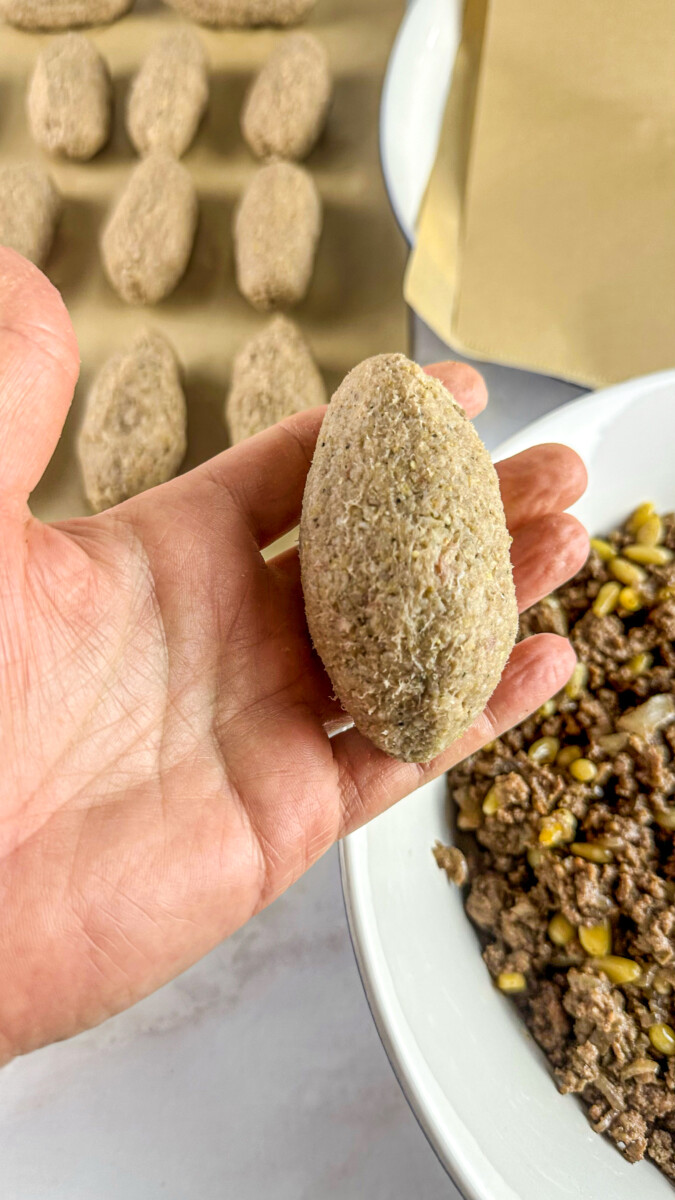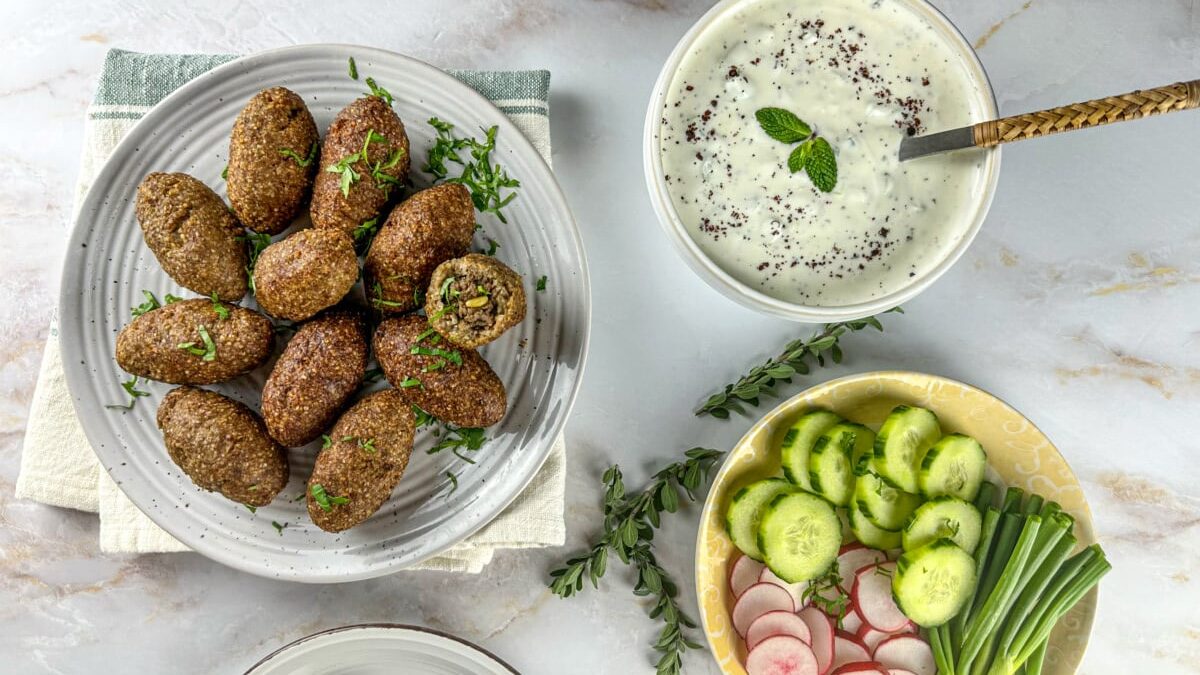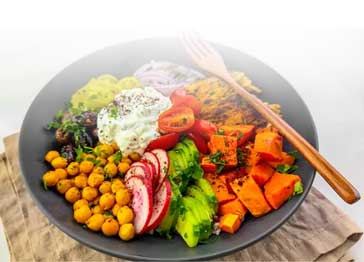Kibbeh: A labor of love, a burst of bold flavors, and a Middle Eastern delicacy worth savoring. Get ready to dive into this timeless classic!
This delicate Lebanese Kibbeh Recipe —a true labor of love—was a staple in my mom’s kitchen. I still remember the rhythmic motion of her hands as she and my aunt prepared large batches, carefully shaping and stuffing each piece before tucking them away in the freezer for when cravings struck. Watching her blend bulgur, seasoned meat, and spices, then shape the mixture into delicate shells filled with onions and toasted pine nuts, was mesmerizing. The process demands patience, precision, and skill—so when you taste perfectly made Kibbeh, you know it’s been crafted with heart.
A culinary masterpiece of the Middle East, Kibbeh is a must-have for any mezze spread. Pair it with creamy hummus, fiery muhammara, and warm pita, or enjoy it alongside tangy moutabal and refreshing tabbouleh for the ultimate flavor experience.
After years of hesitation, I finally took the plunge—and now, I’m thrilled to share this step-by-step guide so you, too, can master this timeless dish. Whether you’re a seasoned cook or trying kibbeh-making for the first time, these tips will help you create golden, crispy, flavor-packed bites that are sure to impress. Who knows? You might even find yourself proudly sharing your own photos of this delicious Lebanese classic!
Key Ingredients for Kibbeh Recipe
- Bulgur: The choice of #1 bulgur is crucial for achieving Kibbeh’s smooth and desirable texture. It’s essential to wash and drain the Bulgur thoroughly, but avoid soaking it, as it needs to maintain some firmness. Patting it dry ensures the right consistency in the shell.
- Herbs: The combination of dry mint and fresh or dry marjoram infuses Kibbeh with its distinctive Middle Eastern flavors. These herbs add aromatic complexity and contribute to the overall taste profile.
- Ground Beef: Lean ground beef forms the heart of the Kibbeh shell, providing the necessary meaty richness and texture. It’s essential to choose lean beef for a balanced result.
- Spices: The blend of salt, cinnamon, and black pepper adds layers of flavor to the Kibbeh shell, enhancing its taste and aroma.
- Ice-Cold Water: Adding ice-cold water in the right proportion is crucial to achieve the proper consistency of the Kibbeh shell. It helps bind the ingredients and create the desired texture.
- Regarding the stuffing, ingredients like ghee, olive oil, ground lamb or beef, spices, lemon juice, and, most notably, pomegranate molasses play significant roles in imparting rich, savory, and tangy flavors. The pomegranate molasses adds a unique and essential depth to the stuffing, enhancing the overall taste profile of the dish. Additionally, toasted pine nuts contribute a delightful crunch and nutty flavor, completing the stuffing’s delicious composition.
Tips and Notes for Perfecting Kibbeh Recipe
If you’re new to cooking Kibbeh, these tips will help you create an authentic and delicious dish:
- Bulgur Basics: Use #1 bulgur for the best results. Remember not to soak it; wash it thoroughly to remove impurities, then pat it dry with a paper towel. This ensures a smooth, crispy shell with a perfectly cooked interior.
- Lean Meat Choice: Opt for at least 90% lean ground beef when making the shell for a balanced texture and flavor.
- Shaping Skill: Shaping Kibbeh may take some practice, so be patient; it’s a skill that improves over time.
- Freezing for Convenience: Consider freezing Kibbeh before frying. Lay them flat on parchment paper inside a Ziplock bag and place them in the freezer for easy access.
- Frying Expertise: Frying Kibbeh can be a bit tricky. Ensure the oil is hot enough and there’s enough of it to cover the Kibbeh. Avoid overcrowding the pan; let them sit for about 30 seconds before flipping.
- Balanced Spices: Use spices in moderation to enhance the dish without overpowering it. Marjoram, fresh or dry, is a popular choice, but fresh basil works well too. You can also experiment with spices like cumin and mace for added flavor.
With these tips, you’ll be on your way to mastering the art of crafting perfect Kibbeh.
Varieties of Lebanese Kibbeh
Lebanese Kibbeh is a beloved Middle Eastern dish cherished by enthusiasts worldwide. Its versatility allows it to be served in various ways, making it suitable as a main course, appetizer, or snack, often accompanied by various sides and dipping sauces. Here are some common variations:
- Fried Kibbeh: This classic variation involves deep-frying balls or patties made from ground meat and bulgur wheat. The result is a crispy delight that’s widely enjoyed.
- Raw Kibbeh (Kibbeh Nayeh): A delicacy among Kibbeh enthusiasts, this variation is made from finely ground beef or lamb combined with Bulgur, onions, and a blend of spices. It’s often served with fresh herbs and a drizzle of olive oil, showcasing its rich flavors.
- Baked Kibbeh: On the other hand, it offers a healthier twist. It is created by layering the Kibbeh mixture in a baking dish and then baking it until it becomes crispy and golden brown. It pairs wonderfully with yogurt or tahini sauce.
- Other Variations: Lebanese Kibbeh offers a world of culinary exploration. You can discover grilled, stuffed, or boiled versions with unique flavor and texture. These variations open up a world of diverse possibilities for savoring this beloved Middle Eastern dish.
What is Bulgur, and Where can you Find it?
Bulgur is a crucial ingredient in kibbeh recipes, and the quality of Bulgur you use can significantly impact the final result. It’s a whole, unrefined grain commonly used in Lebanese cooking.
You can typically find Bulgur in well-stocked grocery stores, often located near other grains like dry beans, rice, and barley pearls. With the growing popularity of diverse cooking ingredients, many stores now carry Bulgur.
If you’re looking for a wider selection or prefer to shop at Middle Eastern stores, they will likely have Bulgur readily available. Additionally, you can easily order Bulgur online if it’s not readily accessible in your local stores. Rest assured, you will likely find this essential ingredient for your kibbeh recipe.
Step-by-Step Instructions
Cook the Onions & Meat for Perfect Kibbeh Filling

Season & Enhance the Meat Filling

Turn off the heat and remove the skillet from the stovetop. In a separate bowl, mix the cooked meat mixture with toasted pine nuts until evenly incorporated. Set aside until ready to use.
Blend Onion & Bulgur for the Kibbeh Dough

Blend Meat & Spices for the Kibbeh Dough

Prepare & Portion the Kibbeh Dough

For perfectly shaped kibbeh, divide the dough evenly, weighing each piece to 4 oz, or simply eyeball and shape them into balls.
Pro Tip: Keep a cup of water nearby to dip your fingers in while shaping. This prevents the dough from sticking and ensures smooth, well-formed kibbeh.
Shape the Kibbeh Shell

Fill the Kibbeh with the Flavorful Stuffing

Seal & Shape the Kibbeh

Shape & Arrange the Kibbeh

Fry the Kibbeh Until Golden Brown

Perfectly Fried Kibbeh: Crispy & Golden Every Time

Serve warm and enjoy this crispy, flavor-packed Lebanese delicacy with your favorite dips and sides!
Ingredients:
| 2 tablespoons ghee | |
| 2 tablespoons olive oil | |
| 2 cups chopped onion (one large onion or two small ones) | |
| 1 lb. ground lamb or beef | |
| 1 teaspoon salt | |
| ½ teaspoon black pepper | |
| ½ teaspoon seven-spice powder | |
| ¼ teaspoon cinnamon | |
| 2 tablespoons fresh lemon juice | |
| 2 tablespoon pomegranate molasses | |
| ¼ cup toasted pine nuts |
Making the Kibbeh Shell:
| 1 large onion (chopped roughly) | |
| 2 cups bulgur # 1 (washed and drained) | |
| 1 lb. lean ground beef | |
| 2 teaspoons salt | |
| 1 teaspoon dry mint | |
| 1 teaspoon fresh or dry marjoram | |
| ¼ teaspoon cinnamon | |
| ¼ teaspoon black pepper | |
| ½ cup ice cold water or as needed |
Preparation
Heat the ghee and olive oil in a large skillet over medium heat. Once warm, add the chopped onions and sauté for about 5 minutes until soft and fragrant. Next, add the ground meat, breaking it apart with a wooden spoon. Cook for about 8 minutes, stirring occasionally, until lightly browned.
Sprinkle the salt, pepper, seven spices, and cinnamon over the meat, mixing well to evenly coat. Cook for another 1-2 minutes, allowing the spices to blend into the mixture. Stir in the lemon juice and pomegranate molasses, ensuring everything is well combined. Turn off the heat and remove the skillet from the stovetop. In a separate bowl, mix the cooked meat mixture with toasted pine nuts until evenly incorporated. Set aside until ready to use.
In a food processor, combine the chopped onion and washed bulgur. Pulse until the mixture is well blended and evenly combined..
Add the ground beef, spices, salt, dry mint, fresh marjoram, cinnamon, and black pepper to the food processor. While blending, slowly pour in ½ cup of ice-cold water from the top. Continue mixing for 30 seconds until the mixture is well combined and smooth.
Transfer the mixture into a bowl. If needed, add a little water to achieve the right consistency—it should hold together without being too dry or too loose. For perfectly shaped kibbeh, divide the dough evenly, weighing each piece to 4 oz, or simply eyeball and shape them into balls. Pro Tip: Keep a cup of water nearby to dip your fingers in while shaping. This prevents the dough from sticking and ensures smooth, well-formed kibbeh.
Take one dough ball in your hand and begin shaping the kibbeh. Using the index finger of your other hand, gently press into the center to create a hole. Carefully expand it, working the dough outward to form a hollow shell with a wide opening, making space for the filling.
Generously fill the hollowed kibbeh shell with a spoonful of the prepared stuffing, ensuring it's packed in without overfilling. This will help maintain the perfect shape while sealing.
After filling the kibbeh shell with stuffing, gently pinch the open end to seal it. Carefully shape it into the classic oval or football-like shape, ensuring the filling stays securely inside. Repeat with the remaining dough balls.
Continue shaping the kibbeh one at a time, dipping your fingers in cold water as needed to prevent sticking. Place each kibbeh on a parchment-lined baking sheet, ensuring they are spaced apart. This prevents them from sticking together and tearing before cooking.
Heat enough oil in a deep pan to fully submerge the kibbeh. Once the oil is hot, carefully drop in the kibbeh and fry for about one minute, or until they turn light golden brown. Avoid overcrowding the pan to ensure even cooking.
Fry the kibbeh in small batches to maintain the oil temperature and ensure even cooking. Once golden brown, carefully remove each kibbeh and place it on a paper towel-lined plate to drain excess oil. Serve warm and enjoy this crispy, flavor-packed Lebanese delicacy with your favorite dips and sides!
Rana’s Notes!
Nutrition Information
The information shown is an estimate provided by an online nutrition calculator. It should should not be considered a substitute for a professional nutritionist's advice.
See our full nutrition disclosure here.







Have you made this Lebanese Kibbeh? I love to hear your feedback. Feel free to leave me a comment below.